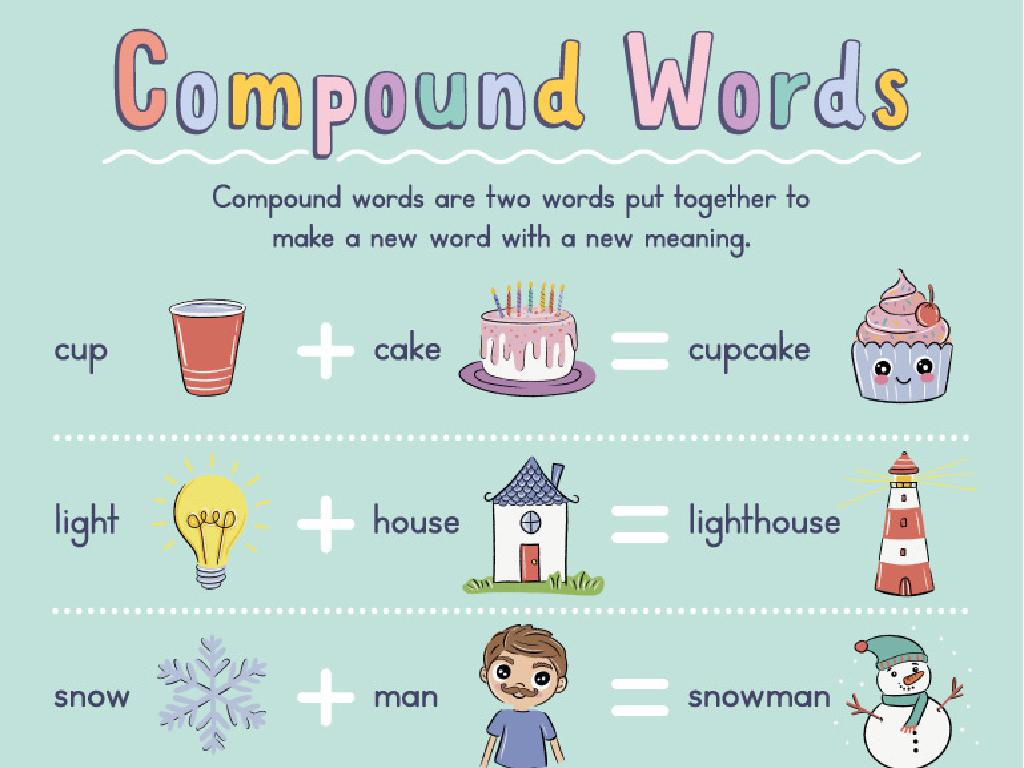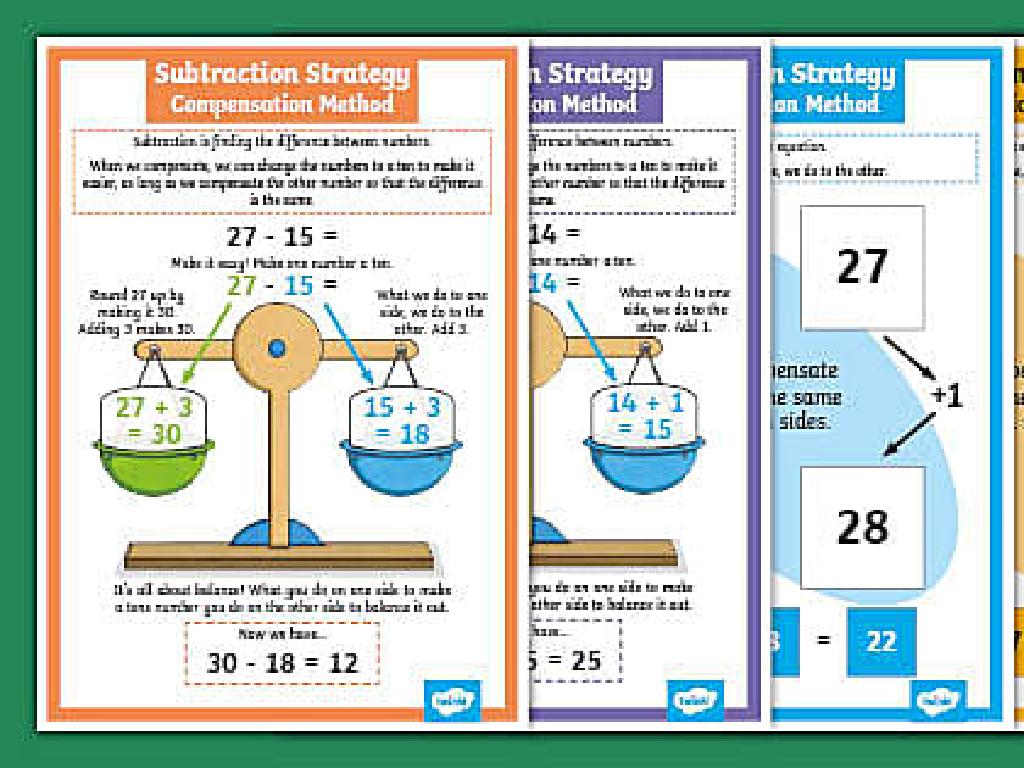Use Compensation To Subtract - Up To Two Digits
Subject: Math
Grade: Second grade
Topic: Subtraction Strategies: Two Digits
Please LOG IN to download the presentation. Access is available to registered users only.
View More Content
Using Compensation to Subtract
– Learn a cool subtraction strategy
– ‘Using Compensation’ explained
– If 53 – 29 is hard, change 29 to 30, subtract to get 23, then add 1 back.
– Simplifies two-digit subtraction
– Instead of borrowing, adjust numbers to make it easy.
– Practice with examples
|
Today’s lesson introduces second graders to the concept of using compensation as a strategy for subtracting two-digit numbers. This method involves adjusting one of the numbers to make the subtraction easier and then compensating for that adjustment at the end. For example, if students find it difficult to subtract 29 from 53, they can round 29 up to 30, subtract to get 24, and then add the 1 they ‘borrowed’ to get the correct answer of 23. This technique helps avoid the more complex borrowing method and can be quicker once students are comfortable with it. During the lesson, provide several examples and guide the students through the process step by step. Allow them to practice with problems of varying difficulty and encourage them to explain their reasoning.
Making Subtraction Simple with Compensation
– Understanding compensation
– Compensation means adjusting numbers to make math easier.
– Adjust numbers for easy subtraction
– If we have 52 – 29, we can change 29 to 30 to subtract easily.
– Rounding numbers to subtract
– Rounding up or down to the nearest ten can simplify subtraction.
– Practice with examples
|
Compensation is a subtraction strategy that helps make mental math easier for second graders. By adjusting one or both numbers to a rounder, more manageable figure, students can subtract more quickly and with less chance of error. For example, if the problem is 52 – 29, it’s easier to think of 29 as 30, subtract to get 22, and then add 1 back to account for the rounding. This slide will introduce the concept of compensation and provide students with the opportunity to practice rounding numbers and using this technique to subtract two-digit numbers. Encourage students to explain their thought process as they use compensation to ensure they understand the concept.
Using Compensation to Subtract
– Start with 43 – 29
– Round 29 to 30
– Makes subtraction easier
– Subtract 43 – 30
– Gives us 13
– Adjust for the rounding
– Since we added 1 to 29, we subtract 1 from 13 to get 12
|
This slide introduces the concept of compensation in subtraction, which is a useful strategy for second graders to simplify their calculations. By rounding a number to the nearest ten, students can more easily subtract and then adjust their answer to account for the rounding. It’s important to walk through this process step by step, ensuring that students understand why we compensate and how it affects the final answer. Practice with additional examples like 54 – 28 or 76 – 49 to reinforce the concept. Remember to encourage students to explain their reasoning during the process to solidify their understanding.
Let’s Practice Compensation in Subtraction!
– Start with 54 – 26
– Round 26 to 30 to simplify
– Rounding makes it easier to subtract
– Subtract: 54 – 30 = ?
– What is 54 minus 30?
– Adjust for the rounding
– Add back the extra we rounded off
|
This slide is an interactive class activity to practice the compensation strategy for subtraction. Begin by presenting the problem 54 – 26 and guide the students to round 26 up to 30 to make the subtraction easier. After calculating 54 – 30, remind students to adjust the final answer by adding back the amount that was rounded off. For example, since 26 was rounded up to 30, they need to add back the difference of 4 to the result of 54 – 30. This exercise helps students understand how to use rounding as a tool to simplify subtraction problems and reinforces the concept of compensation. Possible activities include pairing students to work on similar problems, using manipulatives to visualize the compensation, or creating a worksheet with a series of problems to practice this strategy.
Your Turn to Try: Compensation Strategy
– Start with 67 – 48
– Round 48 to 50
– Rounding makes it easier to subtract
– Subtract 50 from 67
– 67 – 50 equals 17
– Adjust the final answer
– Add back the 2 you rounded off
|
This slide is an interactive practice for students to apply the compensation strategy in subtraction. Students will start with the problem 67 – 48. They should round 48 to 50 to make it easier to subtract from 67. After subtracting, they will get 17. Since they rounded 48 up to 50, they subtracted an extra 2. To adjust their answer, they need to add the 2 back to 17, giving them the correct answer of 19. Encourage students to explain their thought process and ensure they understand why and how the compensation strategy works. This exercise will help solidify their understanding of rounding and adjusting in subtraction.
Why Use Compensation in Subtraction?
– Makes big numbers manageable
– Turn a hard problem into an easier one!
– Quick mental subtraction
– Subtract numbers faster without paper.
– Checks work for mistakes
– Double-check answers to avoid errors.
|
Compensation is a useful strategy for second graders to simplify subtraction problems, especially when dealing with two-digit numbers. It involves adjusting one number to make the math easier and then compensating for that adjustment at the end. For example, if subtracting 47 from 53, we can adjust 47 to 50, subtract to get 3, and then add back the difference between 47 and 50. This method helps students to perform subtraction quickly in their heads and provides a way to verify their answers, enhancing their number sense and confidence in solving math problems.
Class Activity: Subtraction Bingo
– Play Bingo with subtraction
– Use compensation strategy
– Adjust numbers to make subtraction easier
– Find answers to win
– Aim for five in a row
|
This interactive class activity is designed to help second-grade students practice the compensation strategy in subtraction. Set up a Bingo game where each square contains a different subtraction problem up to two digits. Teach students to round numbers to the nearest ten to simplify the subtraction process, then adjust their final answer accordingly. For example, if the problem is 43 – 18, they might round 18 to 20, subtract to get 25, and then add 2 to compensate for the rounding. The first student to solve five problems in a row and call out ‘Bingo!’ wins a small prize. Prepare several variations of the Bingo cards to ensure a dynamic game and have a list of possible prizes that will motivate the students. This activity will reinforce their understanding of subtraction and the use of compensation to find answers more efficiently.
Mastering Compensation in Subtraction
– Congratulations on learning compensation!
– Practice it to become a subtraction star
– Try subtracting numbers with your toys or snacks
– Keep practicing at home for perfection
– Excited for the next subtraction strategy?
– Get ready for more fun with numbers!
|
This slide is meant to congratulate the students on their hard work and encourage them to continue practicing the compensation strategy for subtraction at home. Remind them that practice is key to mastering any new skill. Provide suggestions for practicing, such as using toys or snacks to create subtraction problems. Highlight the importance of consistent practice to build confidence and proficiency. Finally, generate excitement for the upcoming lessons by hinting at another subtraction strategy they will learn, keeping their curiosity and enthusiasm for math alive.






